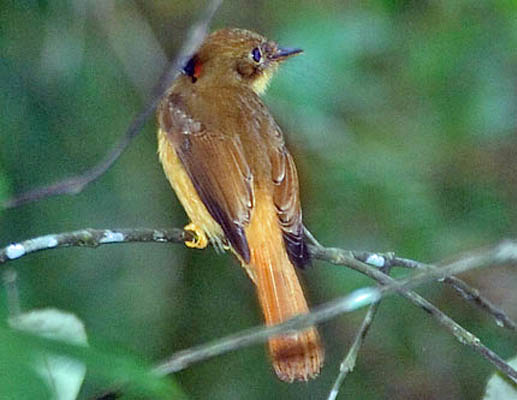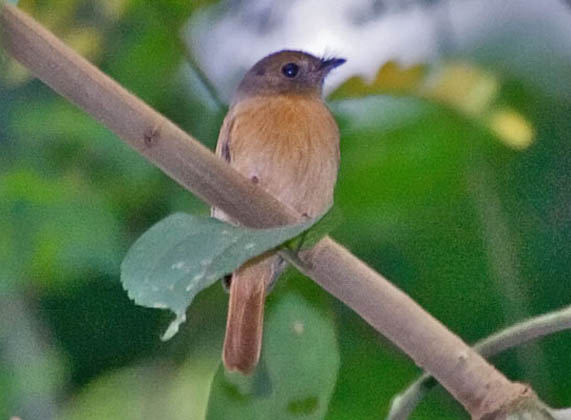
a web page by Don Roberson |
ROYAL FLYCATCHERS & ALLIES Onychorhynchidae |
|
When the Tyrannidae account in the Handbook of the Birds of the World was published in 2004 (Fitzpatrick et al. 2004), it had 429 species. Even then, anatomical evidence showed some oddities. One example was a syringeal character — the presence of an intrinsic M. obliquus vertalis muscle — in the vast majority of tyrannids. This syringeal muscle was missing in a few genera, including Myiobius, Onychorhynchus, and Terenotriccus (Fitzpatrick et al. 2004). A member of that set is Sulphur-rumped Flycatcher of Central and northern South America (left). |
| Published
studies by Tello & Bates (2007), Rheindt et al. (2008), Tello et
al. (2009), and Ohlson et al. (2008, 2013) have been very useful in
unraveling the relationships of Tyrant Flycatchers and relatives, but
they have not agreed on all points. Tello and Bates (2007) discovered a
small isolated clade, which they called the “Myiobius
assemblage," that they and Rheindt et al. (2008) thought was a early
branch in the Tyrannida. Ohlson et al. (2008) found that the “Myiobius
assemblage” was a basal group and then Ohlson et al. (2013) found that
it was sister group, as was the Sharpbill, to all the rest of the
Tyrant Flycatchers. Sharpbill had previously been elevated to Family
status by SACC and other authorities. Ohlson et al. (2013) argued in
favor of elevating the group to Family status, the Onychorhynchidae,
which we'll call the Royal Flycatcher & allies, as the latin name
for the new family comes from Royal Flycatcher. The AOU adopted this
Family status in their summer 2018 supplement. I follow here. Clements/eBird and other authorities have not yet authorized this family split, noting that Ohlson et al. (2013) had also proposed Family status for the Pipritidae (Piprites), the Platyrinchidae (Spadebills & allies), the Rhynchocyclidae (Mionectine flycatchers), and the Tachurididae (Many-colored Rush Tyrant). They, and the SACC, are awaiting the results of a larger study of the entire Tyranni, due out perhaps in 2019. At this moment in time, the IOC considers this group a member of the Tityridae. World birders should be aware of all these potential families, in addition to the just-split Onychorhynchidae. |
Royal Flycatcher is widespread in low numbers throughout the lowland forests of the Neotropics, from Mexico to southeastern Brazil, but is sometimes split into four more localized species. |
The final species in this new family is the rather widespread Ruddy-tailed Flycatcher (photo, left, by Arthur Grosset). It, too, has long rectal bristles, a characteristic of this Family. Ruddy-tailed usually forages alone, searching from a perch, in vertical posture, often flicking wings quickly over its back. It abruptly darts in pursuit of prey, using aerial sallies or hover-gleaning maneuvers (Fitzpatrick et al. 2004). |
Photos: The Sulphur-rumped Flycatcher Myiobius sulphureipygius was at Rio Tigre, Costa Rica, on 25 Dec 2007. Arthur Grosset photographed the Royal Flycatcher Onychorhynchus coronatus at Intervales NP, southeastern Brazil, in April 2004. Arthur Grosset photographed the Ruddy-tailed Flycatcher Terenotriccus erythrurus in March 2003 at Rondonia, Brazil. Uncredited photos © Don Roberson. Credited photos © Arthur Grosset, as credited, and used with permission; all rights reserved. Many Neotropical bird photos are on his web site. Bibliographic note: There is no "family book" per se, but a introduction to this family, when it was embedded in the Tyrannidae, is in Fitzpatrick et al. (2004). Literature cited:
|
 The
revolution in avian taxonomy that arose from molecular analysis split
up the huge families in the Old World two decades ago. The Old World
Warblers were transferred to a dozen or so families; the Babblers into
seven or more. The nine-primaried New World passerines were split into
more than a dozen families just a few years ago. It was only a matter
of time before studies reached the Tyrant Flycatchers.
The
revolution in avian taxonomy that arose from molecular analysis split
up the huge families in the Old World two decades ago. The Old World
Warblers were transferred to a dozen or so families; the Babblers into
seven or more. The nine-primaried New World passerines were split into
more than a dozen families just a few years ago. It was only a matter
of time before studies reached the Tyrant Flycatchers. All six members of this new family are retiring species of the dark forest understory. Royal Flycatcher
may be the most retiring member of the entire group (photo, right, by
Arthur Grosset). It is a short-legged, mouse-colored bird with a pale
rump and slightly 'hammer-headed' look. Fitzpatrick et al. (2004) note
that "On closer inspection the broad-based bill seems unusually long,
tipped with a prominent hook and surrounded by lengthy rictal bristles.
These almost cat-like whiskers are the longest in the family. Only in
display is the bird's real secret revealed. Each feather of the crest
is greatly elongated, yellowish-orange in the female, scarlet in the
male, and tipped with iridescent violet-black. The crest is fanned out
vertically and laterally to produce a peacock-tail of vivid color. To
accentuate the impression, the mouth is usually opened to show a bright
orange lining, and the head is tipped form side to side in a steady
mechanical fashion. It is postulated that this display occurs in
courtship and during intra-sexual competition, but it is very rarely
seen in the field. In general day-to-day behavior, the crest is furled
and almost invisible."
All six members of this new family are retiring species of the dark forest understory. Royal Flycatcher
may be the most retiring member of the entire group (photo, right, by
Arthur Grosset). It is a short-legged, mouse-colored bird with a pale
rump and slightly 'hammer-headed' look. Fitzpatrick et al. (2004) note
that "On closer inspection the broad-based bill seems unusually long,
tipped with a prominent hook and surrounded by lengthy rictal bristles.
These almost cat-like whiskers are the longest in the family. Only in
display is the bird's real secret revealed. Each feather of the crest
is greatly elongated, yellowish-orange in the female, scarlet in the
male, and tipped with iridescent violet-black. The crest is fanned out
vertically and laterally to produce a peacock-tail of vivid color. To
accentuate the impression, the mouth is usually opened to show a bright
orange lining, and the head is tipped form side to side in a steady
mechanical fashion. It is postulated that this display occurs in
courtship and during intra-sexual competition, but it is very rarely
seen in the field. In general day-to-day behavior, the crest is furled
and almost invisible." There are four "pale-rumped" flycatchers in the genus Myiobius: Sulphur-rumped (shown above), Tawny-breasted Flycatcher Myiobius villosus, Whiskered Flycatcher M. barbatus, and Black-tailed Flycatcher M. atricaudus. Between them they inhabit most of the Central and South American lowlands. Myiobius
flycatchers forage from low to middle levels and can often fan their
tails, recalling to some extent the Old World fantails. The members of
the genus use flush-and-drop strategies, pursuing flushed prey in
short, acrobatic, aerial sallies. All have prominent long rictal
bristles.
There are four "pale-rumped" flycatchers in the genus Myiobius: Sulphur-rumped (shown above), Tawny-breasted Flycatcher Myiobius villosus, Whiskered Flycatcher M. barbatus, and Black-tailed Flycatcher M. atricaudus. Between them they inhabit most of the Central and South American lowlands. Myiobius
flycatchers forage from low to middle levels and can often fan their
tails, recalling to some extent the Old World fantails. The members of
the genus use flush-and-drop strategies, pursuing flushed prey in
short, acrobatic, aerial sallies. All have prominent long rictal
bristles.